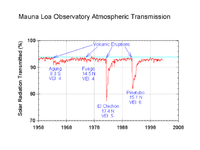
Evaluation of IR radiance simulation for all‐sky assimilation of Himawari‐8/AHI in a mesoscale NWP system
Sign Up to like & getrecommendations! Published in 2017 at "Quarterly Journal of the Royal Meteorological Society"
DOI: 10.1002/qj.3022
Abstract: To assimilate the all-sky infrared radiances of Himawari-8/AHI, we investigated the statistical characteristics of a radiance simulation from a mesoscale cloud-resolving model. Compared with AHI observations, the simulations tended to show insufficiently low brightness temperature… read more here.
Keywords: himawari ahi; mesoscale; radiance simulation; sky ... See more keywords

Using the sky as heat sink: Climatic applicability of night-sky based natural cooling techniques in Europe
Sign Up to like & getrecommendations! Published in 2020 at "Energy Conversion and Management"
DOI: 10.1016/j.enconman.2020.113424
Abstract: Abstract Climate change and environmental degradation are an existential threat faced by Europe and the rest of the world. To overcome these challenges, Europe requires a new growth strategy that transforms the Union into a… read more here.
Keywords: using sky; sky; sky heat; heat sink ... See more keywords

Measuring fluxes of meteor showers with the NASA All-Sky Fireball Network
Sign Up to like & getrecommendations! Published in 2020 at "Planetary and Space Science"
DOI: 10.1016/j.pss.2020.104938
Abstract: Abstract We present an algorithm developed to measure the fluxes of major meteor showers as observed in NASA’s All-Sky Fireball Network cameras. Measurements of fluxes from the All-Sky cameras not only improve the Meteoroid Environment… read more here.
Keywords: sky fireball; fireball network; sky; meteor showers ... See more keywords

Identifying overcast, partly cloudy and clear skies by illuminance fluctuations
Sign Up to like & getrecommendations! Published in 2019 at "Renewable Energy"
DOI: 10.1016/j.renene.2019.01.080
Abstract: Abstract The overcast, partly cloudy and clear sky conditions can determine the diffuse sky radiance and luminance distributions over the sky dome, and thus are crucial for evaluating the solar energy and daylight on and… read more here.
Keywords: overcast partly; illuminance; clear skies; sky ... See more keywords

Cloudy-sky land surface temperature from VIIRS and MODIS satellite data using a surface energy balance-based method
Sign Up to like & getrecommendations! Published in 2021 at "Remote Sensing of Environment"
DOI: 10.1016/j.rse.2021.112566
Abstract: Abstract Land surface temperature (LST) has been effectively retrieved from thermal infrared (TIR) satellite measurements under clear-sky conditions. However, TIR satellite data are often severely contaminated by clouds, which cause spatiotemporal discontinuities and low retrieval… read more here.
Keywords: sky lst; cloudy sky; sky; surface ... See more keywords

Accuracy analysis of computational algorithms for prediction of daylight illuminance in space with shading devices
Sign Up to like & getrecommendations! Published in 2017 at "Solar Energy"
DOI: 10.1016/j.solener.2017.05.048
Abstract: Abstract This study examines the accuracy of annual daylight simulation method (ADSM) in predicting illuminance for spaces with shading device conditions. ADSM algorithms were developed separately for the sun and sky to predict their effect… read more here.
Keywords: daylight coefficient; sky; sky conditions; field ... See more keywords

The flat-sky approximation to galaxy number counts — redshift space correlation function
Sign Up to like & getrecommendations! Published in 2021 at "Journal of Cosmology and Astroparticle Physics"
DOI: 10.1088/1475-7516/2021/07/045
Abstract: We study the flat-sky approximation for galaxy number counts including relativistic effects, and numerically assess its performance and accuracy with respect to the full-sky result. We find an agreement of up to 5% for the… read more here.
Keywords: sky; flat sky; approximation galaxy; galaxy number ... See more keywords

The all-sky medium energy gamma-ray observatory
Sign Up to like & getrecommendations! Published in 2017 at "Journal of Instrumentation"
DOI: 10.1088/1748-0221/12/11/c11024
Abstract: The All-sky Medium Energy Gamma-ray Observatory (AMEGO) is an Astrophysics Probe mission concept designed to explore the MeV sky. It has a unique capability to cover with high sensitivity both the Compton and pair conversion… read more here.
Keywords: gamma ray; sky; energy; energy gamma ... See more keywords

Deep co-added sky from Catalina Sky Survey images
Sign Up to like & getrecommendations! Published in 2021 at "Monthly Notices of the Royal Astronomical Society"
DOI: 10.1093/mnras/stab2246
Abstract: A number of synoptic sky surveys are underway or being planned. Typically, they are done with small telescopes and relatively short exposure times. A search for transient or variable sources involves comparison with deeper baseline… read more here.
Keywords: deep added; sky survey; sky; survey ... See more keywords

The C-Band All-Sky Survey (C-BASS): Template fitting of diffuse galactic microwave emission in the northern sky
Sign Up to like & getrecommendations! Published in 2022 at "Monthly Notices of the Royal Astronomical Society"
DOI: 10.1093/mnras/stac1210
Abstract: The C-Band All-Sky Survey (C-BASS) has observed the Galaxy at 4.76 GHz with an angular resolution of 0${_{.}^{\circ}}$73 full-width half-maximum, and detected Galactic synchrotron emission with high signal-to-noise ratio over the entire northern sky (δ >… read more here.
Keywords: sky; synchrotron; band sky; bass ... See more keywords

Aerosol parameters for night sky brightness modeling estimated from daytime sky images
Sign Up to like & getrecommendations! Published in 2023 at "Monthly Notices of the Royal Astronomical Society"
DOI: 10.1093/mnras/stad1570
Abstract: Atmospheric turbidity is one of key factors influencing the propagation of artificial light into environment during cloudless nights. High aerosol loading can reduce the visibility of astronomical objects, thus the information on atmospheric pollution is… read more here.
Keywords: sky; sky brightness; aerosol parameters; night ... See more keywords